RBSE Solutions for Class 12 Maths Chapter 9 Differential Equations Ex 9.5
Rajasthan Board RBSE Solutions for Class 12 Maths Chapter 9 Differential Equations Ex 9.5 Textbook Exercise Questions and Answers.
Rajasthan Board RBSE Solutions for Class 12 Maths in Hindi Medium & English Medium are part of RBSE Solutions for Class 12. Students can also read RBSE Class 12 Maths Important Questions for exam preparation. Students can also go through RBSE Class 12 Maths Notes to understand and remember the concepts easily.
RBSE Class 12 Maths Solutions Chapter 9 Differential Equations Ex 9.5
Question 1.
(x2 + xy)dy = (x2 + y2)dx
Answer:
Given differential equation is
(x2 + xy)dy = (x2 + y2)dx
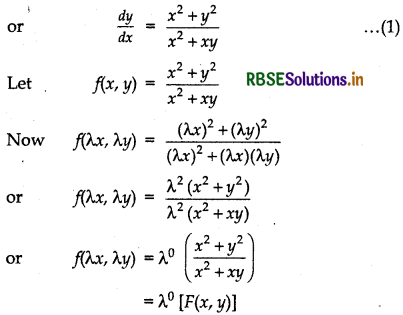
Thus, f(x, y) is a homogeneous function of degree zero.
So, the given differential equation is also homogeneous.
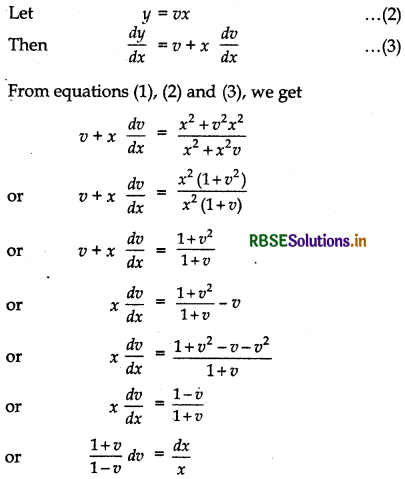
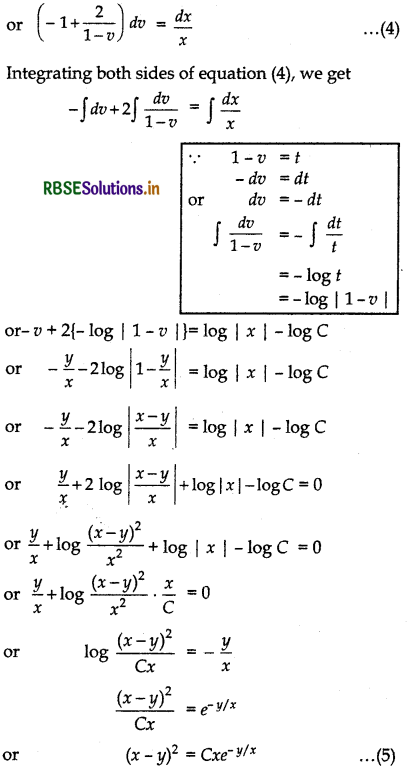
Equation (5) is the required solution of the given differential equation.

Question 2.
y' = \(\frac{x+y}{x}\)
Answer:
Given differential equation is
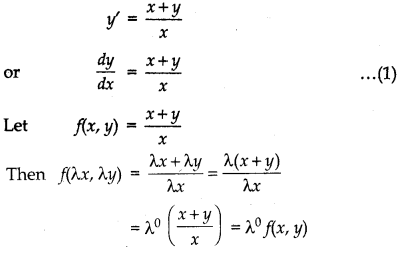
Thus, f(x, y) is a homogeneous function of degree zero.
So, the given differential equation is also homogeneous.
Now putting y = vx ...... (2)
Then \(\frac{d y}{d x}\) = v + x \(\frac{d v}{d x}\) .......... (3)
From equations (1), (2) and (3)
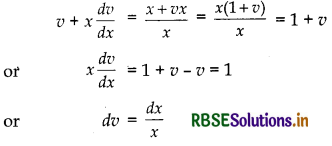
Integrating both sides, we get
∫dv = ∫ \(\frac{d x}{x}\)
or v = log |x| + C
or \(\frac{y}{x}\) = log|x| + C
or y = x log |x| + Cx,
This is the required solution.
Question 3.
(x - y) dy - (x + y) dx = 0.
Answer:
Given differential equation is
(x - y)dy - (x + y)dx = 0
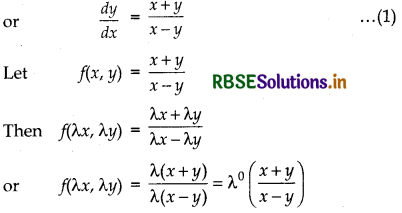
or f(λx, λy) = λ°f(x, y)
Thus, f(x, y) is a homogeneous function of degree zero.
So, the given differential equation is homogeneous.
Now putting y = vx ..... (2)
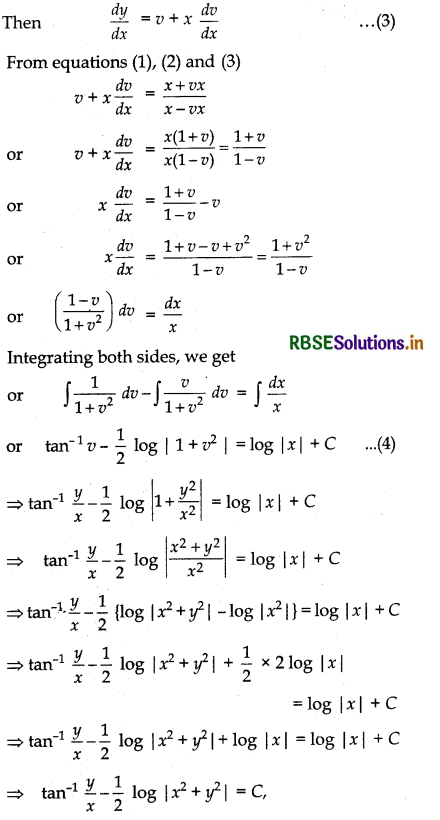
which is the required solution.

Question 4.
(x2 - y2) dx + 2xy dy = 0
Answer:
Given differential equation is
(x2 - y2) dx + 2xy dy = 0
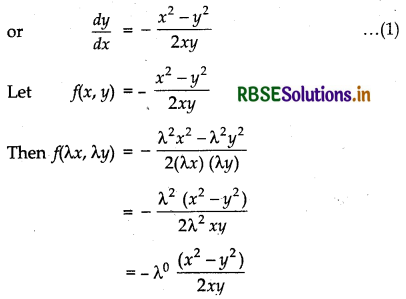
= λ° f(x, y)
∴ f(x, y) is a homogeneous function of degree zero.
Thus, given differential equation is homogeneous.
Putting y = vx ........ (2)
Then \(\frac{d y}{d x}\) = v + x \(\frac{d v}{d x}\) ......... (3)
From equations (1), (2) and (3), we get
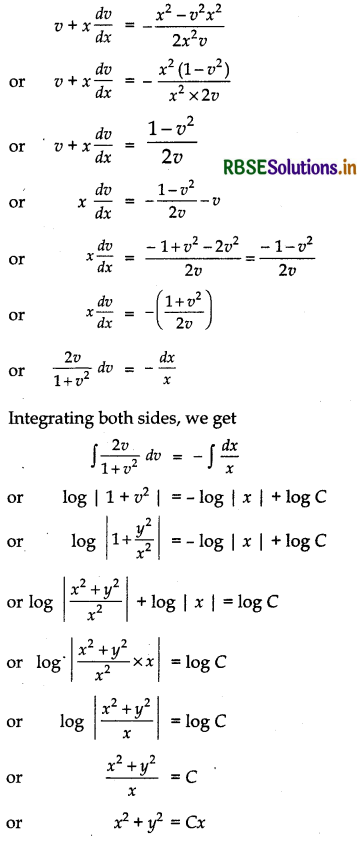
which is the required solution.
Question 5.
x2\(\frac{d y}{d x}\) = x2 - 2y2 + xy
Answer:
Given differential equation is
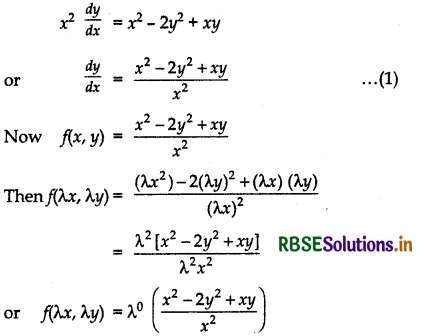
= λ° f(x, y)
∴ f(x, y) is a homogeneous function of degree zero.
Thus, the given differential equation is homogeneous.
Now, putting y = vx ....... (2)
Then \(\frac{d y}{d x} \)= v + x\(\frac{d v}{d x}\) .......... (3)
From equations (1), (2) and (3), we get
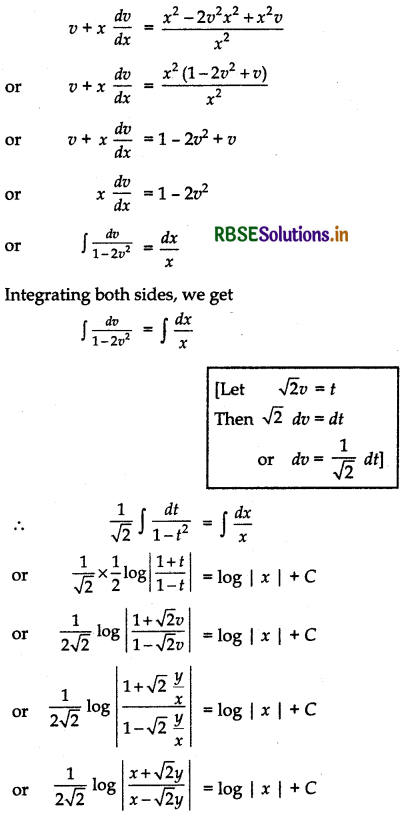
which is the required solution.

Question 6.
x dy - y dx = \(\sqrt{x^2+y^2}\) dx
Answer:
Given differential equation is
x dy - y dx = \(\sqrt{x^2+y^2}\) dx
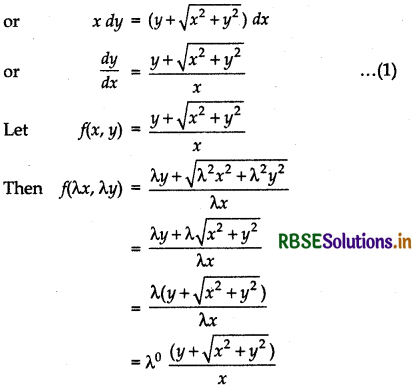
or f(λx, λy) = λ0 f(x, y)
Thus f(x, y) is a homogeneous function of degree zero.
∴ So, the given differential equation is homogeneous.
Now, putting y = vx ............... (2)
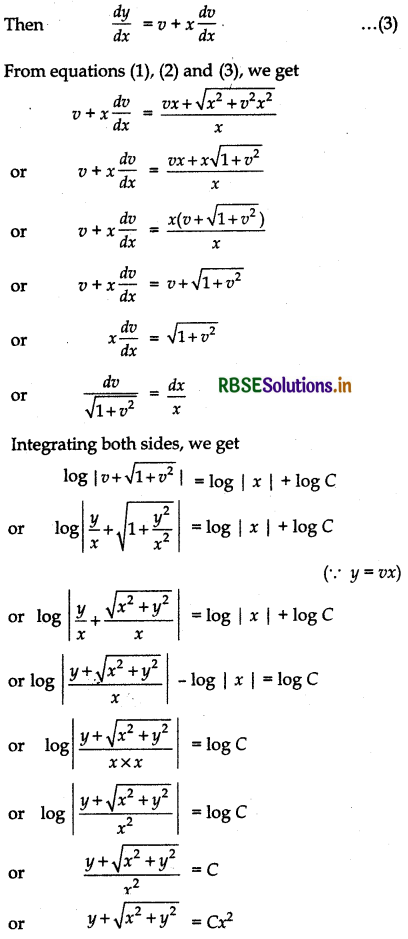
which is the required solution.

Question 7.

Answer:
Given differential equation is
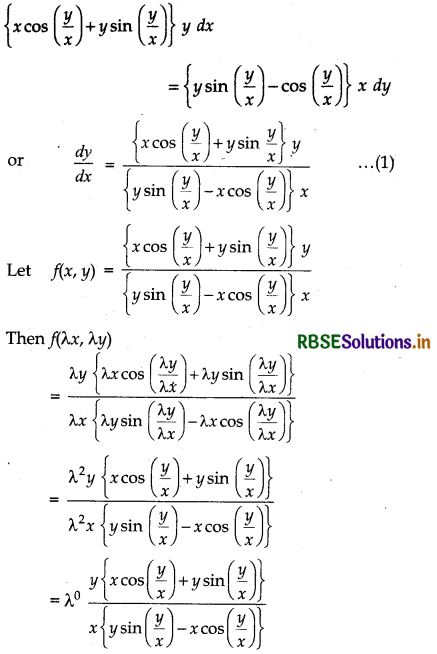
= λ0 f(x, y)
Thus f(x, y) is a homogeneous function of degree zero.
So, the given differential equation is homogeneous.
So putting y = vx ..... (2)
Then \(\frac{d y}{d x}\) = v + x\(\frac{d v}{d x}\) ......... (3)
From equations (1), (2) and (3), we get
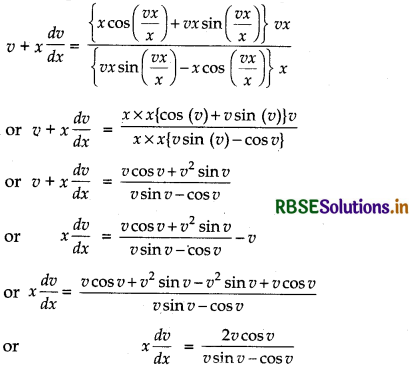
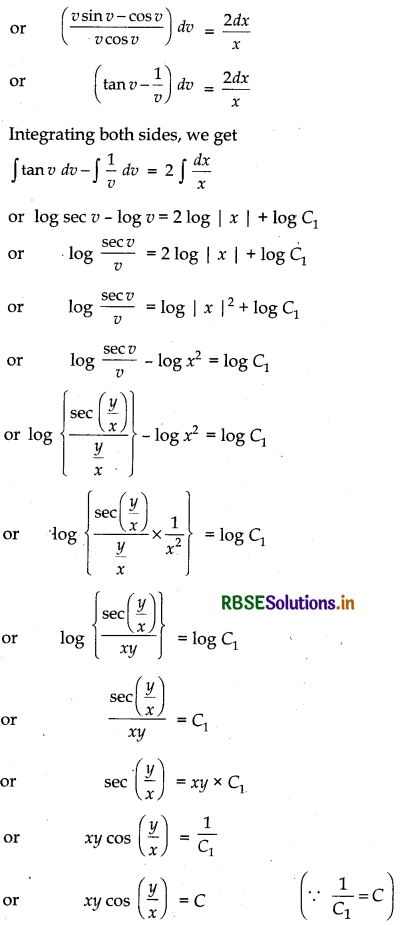
which is the required solution.

Question 8.
x\(\frac{d y}{d x}\) - y + x sin\(\left(\frac{y}{x}\right) \)= 0
Answer:
Given differential equation is
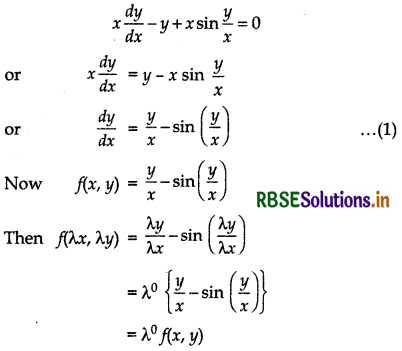
Thus f(x, y) is a homogeneous function of degree zero.
∴ So, the given differential equation is homogeneous.
Putting y = vx ...... (2)
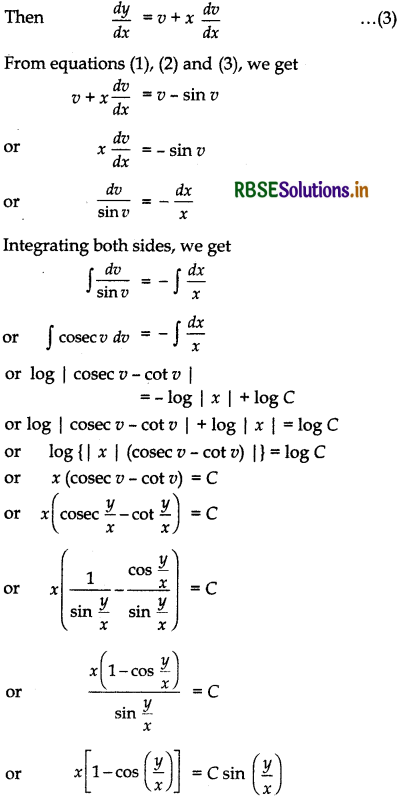
which is the required solution.
Question 9.
y dx + x log \(\left(\frac{y}{x}\right)\) dy - 2x dy = 0
Answer:
Given differential equation is
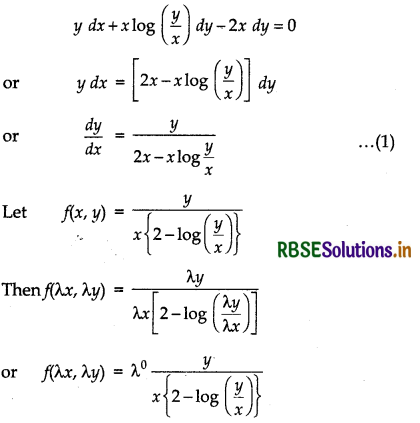
= λ0 f(x, y)
Thus, f(x, y) is a homogeneous function of degree zero.
∴ So, the given differential equation is homogeneous.
Putting y = vx ...... (2)
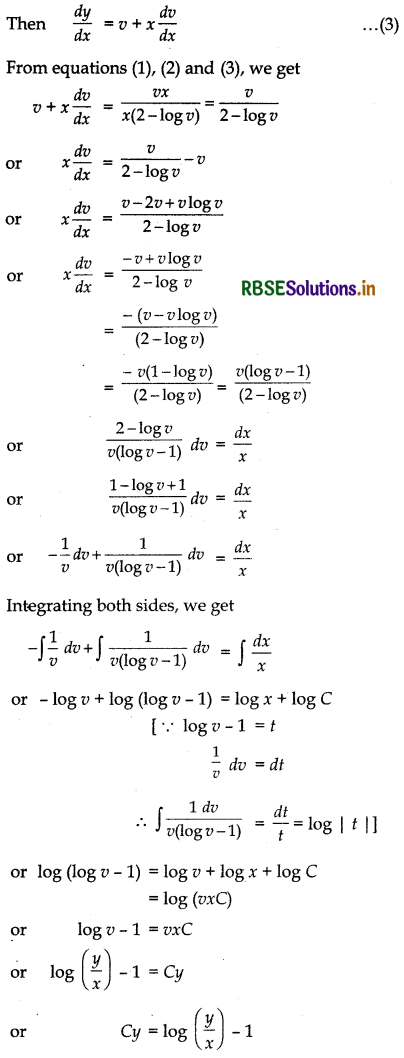
which is the required solution.

Question 10.
(1 + ex/y) dx + ex/y \(\left(1-\frac{x}{y}\right)\) dy = 0
Answer:
Given differential equation is
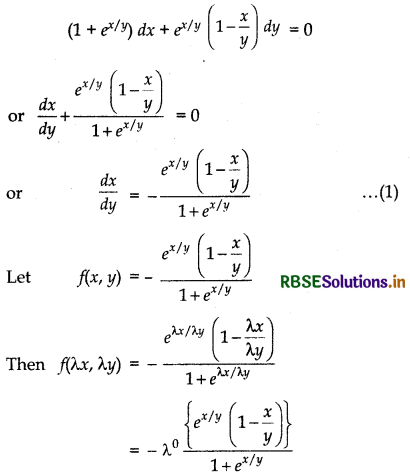
= λ0 f(x, y)
Thus, f(x, y) is a homogeneous function of degree zero.
So, the given differential equation is homogeneous.
Putting x = vy ............ (2)
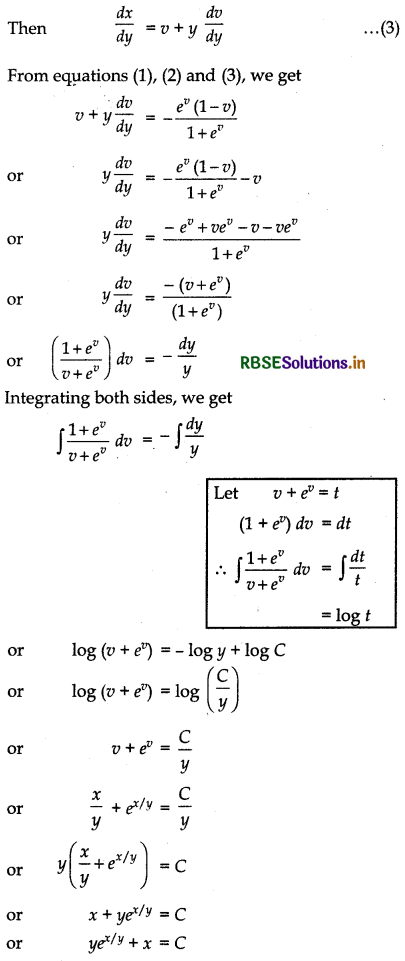
This is the required solution of equation (1).
Question 11.
(x + y) dy + (x - y) dx = 0; y = 1 when x = 1.
Answer:
Given differential equation is
(x + y)dy + (x - y)dx = 0

Clearly, differential equation (1) is homogeneous.
Let, y = vx .......... (2)
Then \(\frac{d y}{d x}\) = v + x \(\frac{d v}{d x}\) ............ (3)
From equations (1), (2) and (3)
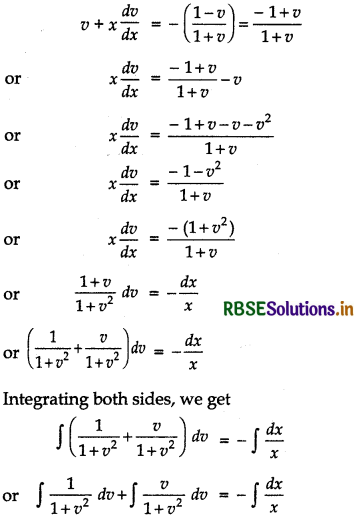
Let 1 + v2 = t
or 2v dv = dt
∴ v dv = \(\frac{1}{2}\) dt
∫\(\frac{v d v}{1+v^2}\) = \(\frac{1}{2}∫\frac{d t}{t}\)
= \(\frac{1}{2}\) log |t|
= \(\frac{1}{2}\) log |1 + v2|
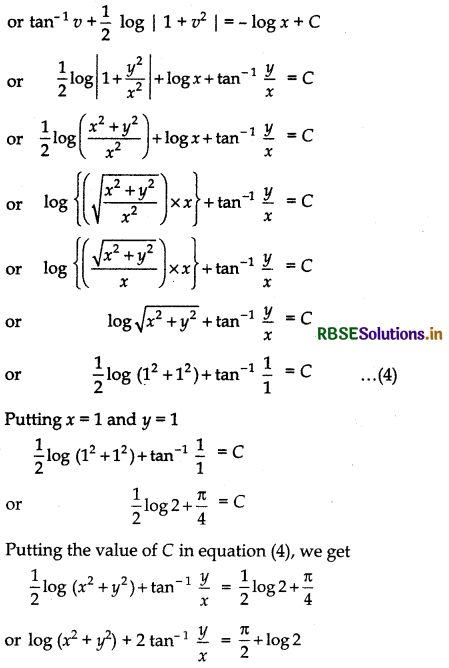
This is the required solution.

Question 12.
x2 dy + (xy + y2) dx = 0; y = 1 when x = 1
Answer:
Given differential equation is
x2 dy + (xy + y2) dx = 0
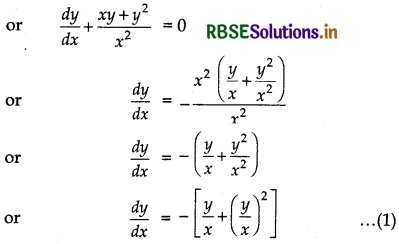
Clearly, it is homogeneous.
Let y = vx .......... (2)
Then \(\frac{d y}{d x}\) = v + x \(\frac{d v}{d x}\) ........... (3)
From equations (1), (2) and (3), we get
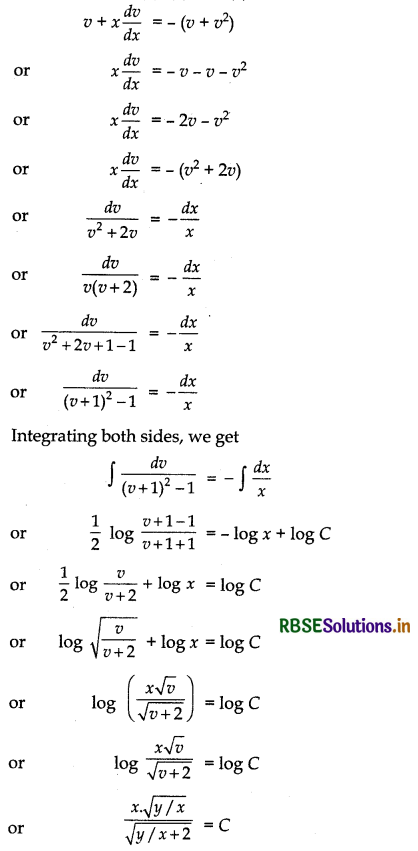
or x2y = C2 (y + 2x)
Putting x = 1 and y = 1 in equation (4), we get
12 × 1 = C2(1 + 2 × 1)
or 1 = C2 (3)
or C2 = \(\frac{1}{3}\)
Putting the value of C2 in equation (4), we get
x2y = \(\frac{1}{3}\)(y + 2x)
or y + 2x = 3x2y
which is the required solution.

Question 13.
[x sin2 \(\left(\frac{y}{x}\right)\) - y] dx + x dy = 0; y = \(\frac{\pi}{4}\) when x = 1.
Answer:
Given differential equation is
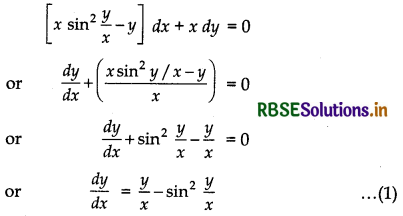
Clearly, equation (1) is homogeneous differential equation.
Let y = vx .......... (2)
Then \(\frac{d y}{d x}\) = v + x \(\frac{d v}{d x}\) .............. (3)
From equations (1), (2) and (3), we get
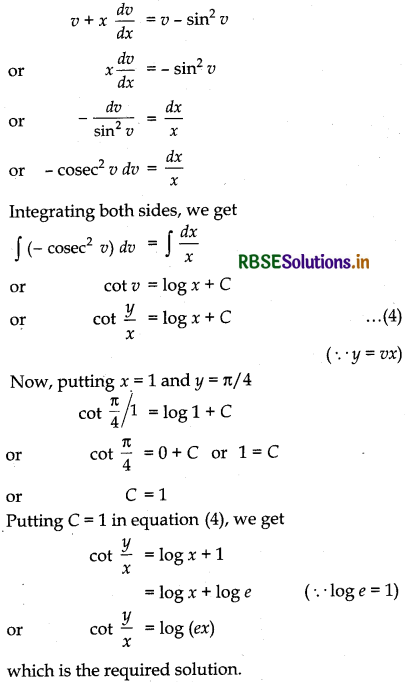
Question 14.
\(\frac{d y}{d x}-\frac{y}{x}\) + cosec \(\left(\frac{y}{x}\right)\) = 0; y = 0 when x = 1.
Answer:
Given differential equation is
\(\frac{d y}{d x}-\frac{y}{x}\) + cosec \(\frac{y}{x}\) = 0
or \(\frac{d y}{d x}\) = \(\frac{y}{x}\) - cosec \(\frac{y}{x}\) ........... (1)
Clearly, equation (1) is, homogeneous differential equation.
Let y = vx .............. (2)
Then \(\frac{d y}{d x}\) = v + x \(\frac{d v}{d x}\) .............. (3)
From equations (1), (2) and (3), we get
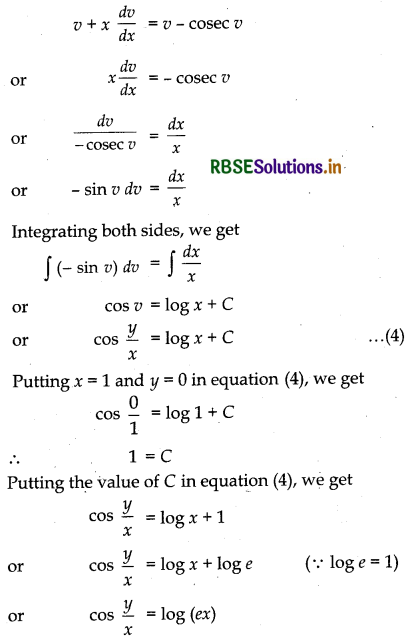
which is the required solution.
Question 15.
2xy + y2 - 2x2\(\frac{d y}{d x}\) = 0; y = 2 when x = 1
Answer:
Given differential equation is
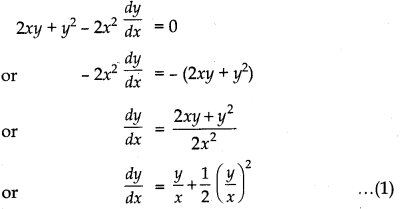
Clearly, equation (1) is homogeneous differential equation
Let y = vx .............. (2)
Then \(\frac{d y}{d x}\) = v + x \(\frac{d v}{d x}\) .............. (3)
From equations (1), (2) and (3), we get
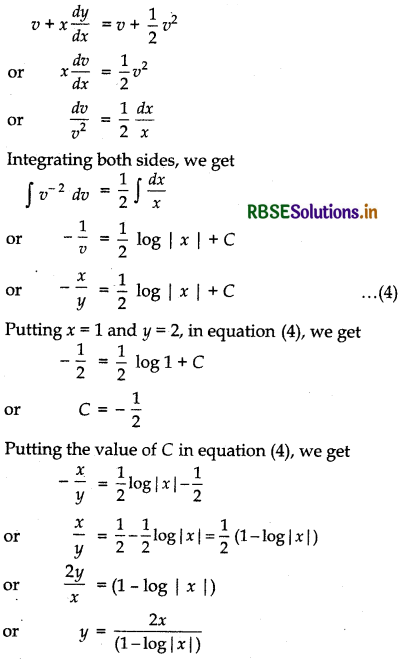
which is the required particular solution, when x ≠ 0, x ≠ e.

Question 16.
A homogeneous differential equation of the form \(\frac{d x}{d y}\) = h\(\left(\frac{x}{y}\right)\) can be solved by making the substitution:
(A) y = vx
(B) v = yx
(C) x = vy
(D) x = v
Answer:
When differential equation is the form of \(\frac{d x}{d y}\) = h\(\left(\frac{x}{y}\right)\), then we substitute x = vy.
Hence, option (C) is correct.
Question 17.
Which of the following is a homogeneous differential equation?
(A) (4x + 6y + 5) dy - (3y + 2x +4) dx = 0
(B) (xy)dx - (x3 + y3)dy = 0
(C) (x3 + 2y2)dx + 2xy dy = 0
(D) y2 dx+ (x2 - xy - y2)dy = 0.
Answer:
Differential equation y2 dx + (x2 - xy - y2) dy dt can be expressed as,
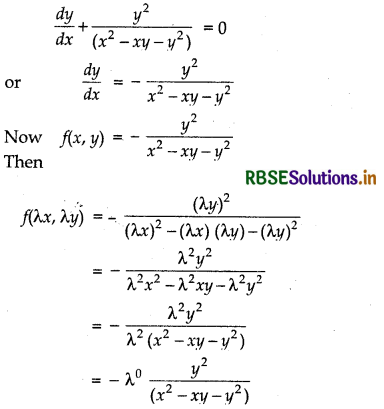
= λ0 f(x, y)
Thus f(x, y) is a homogeneous function of degree zero.
So, the given differential equation is homogeneous.
Hence, option (D) is correct.

- RBSE Class 12 Maths Notes Chapter 13 Probability
- RBSE Class 12 Maths Notes Chapter 12 Linear Programming
- RBSE Class 12 Maths Notes Chapter 11 Three Dimensional Geometry
- RBSE Class 12 Maths Notes Chapter 10 Vector Algebra
- RBSE Class 12 Maths Notes Chapter 9 Differential Equations
- RBSE Class 12 Maths Notes Chapter 8 Application of Integrals
- RBSE Class 12 Maths Notes Chapter 7 Integrals
- RBSE Class 12 Maths Notes Chapter 6 Application of Derivatives
- RBSE Class 12 Maths Notes Chapter 5 Continuity and Differentiability
- RBSE Class 12 Maths Notes Chapter 4 Determinants
- RBSE Class 12 Maths Notes Chapter 3 Matrices